Before Chennai became the bustling metropolis that it is today, bright, artifical light was limited to a few sources. Street lights, name boards of shops and festive lighting were not as widespread. One could actually see stars in the night sky, an act almost impossible these days.
Light pollution has not captured the attention of the masses but continues to grow as an issue that could affect human, animal and plant life in cities. We look at what light pollution means and some of the causes and effects of it across Chennai.
Light pollution and its components
Light pollution refers to excessive and unrestrained usage of artificial lights that can affect humans, animals and the climate, according to the International Dark-Sky Association (IDA), a global organisation combatting light pollution.
There are four major components of light pollution: i) glare; ii) skyglow; iii) light trespass; and iv) clutter
“While travelling in Thiruvanmiyur, I saw an apartment name board illuminated with bright light, which annoyed my eyes,” recalls Yuvan Aves, a naturalist.
When an extremely bright light causes annoyance or irritation to the eyes, it is called glare, according to National Lighting Product Information Program (NLPIP). It could even lower the visibility of a person in extreme cases. “When vehicles on the opposite side of me use high beam headlights, it hurts my eyes,” said a resident from Alapakkam. This is also a classic example of glare.
Skyglow occurs when artificial light brightens up the night sky, according to NLPIP. Therefore the night sky is not visible, let alone the stars. Researchers say that when there is no light pollution, one can see the Milky Way galaxy in the sky from where you are.
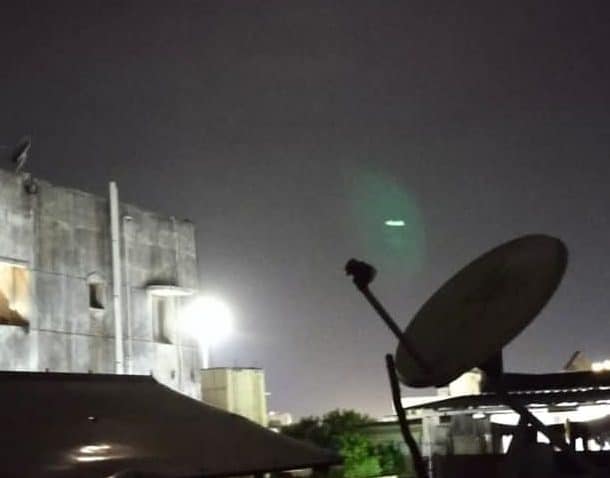
Light trespass refers to a situation when a light source exceeds its purpose, as per NLPIP. For instance, take a street light or a flood light whose purpose is to light up the roads. If that light falls onto an interior area, say, a window of a building, then the light is trespassing into the building.
Clutter refers to an extensive grouping of lights, as given by the IDA. This grouping might collectively generate excessive light. The innumerable lights can confuse motorists and may even lead to accidents.
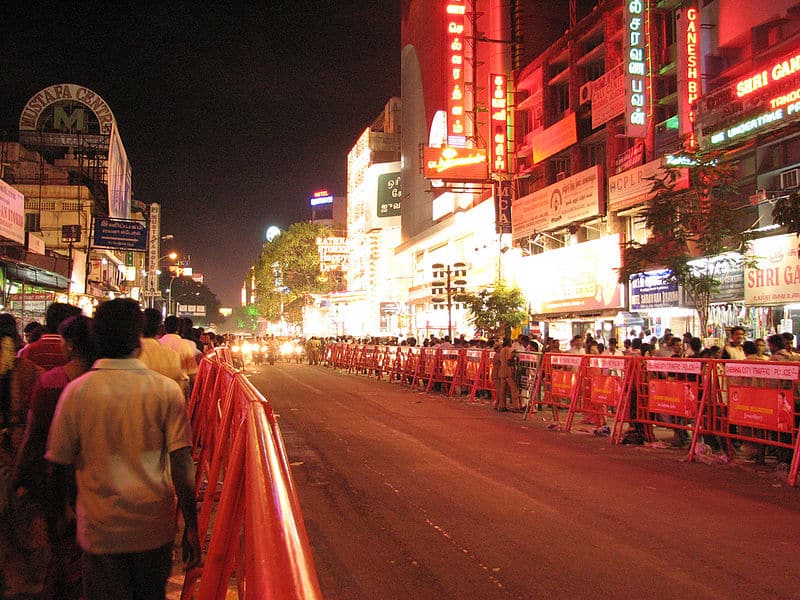
Read more: Noise pollution rockets due to lax enforcement in Chennai
How bright is Chennai?
Depending on the location, many areas of Chennai would fall between 6-8 on the Bortle Scale, with 9 being the highest score. A score of 5 or less will make the Milky Way visible in the sky. Citizen Matters examined the light pollution rate in the city using the Light Pollution Map between 2012 and 2021.
What is Bortle Scale?
The Bortle scale is a nine-level numeric scale that measures the night sky’s brightness of a particular location. It quantifies the astronomical observability of celestial objects and the interference caused by light pollution
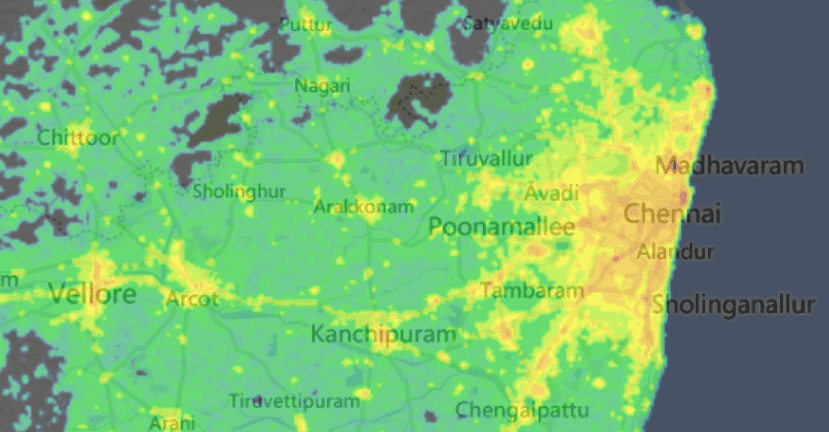
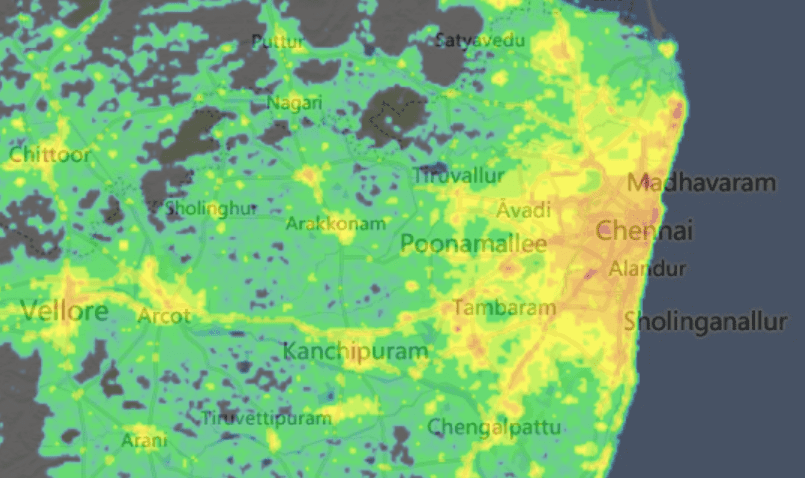
The light pollution data for 2012 and 2021 indicate that the extent of light pollution in Chennai has increased over the years. A study points out that urban sprawl and light pollution rates have a direct correlation. Accounting for urban sprawl in Chennai, another research points out that there has been around a 70.4% increase in urban areas along the peripheries of the city between 1991 and 2016. From the light maps, one can see that light pollution increases with urbanisation.
Zooming in on the light pollution map, one also observes a high amount of light pollution in some areas of Chennai such as the Manali Industrial Area, Koyambedu, Airport and SIPCOT, as well as the stretch along the coast from Marina Beach to Royapuram among other areas.
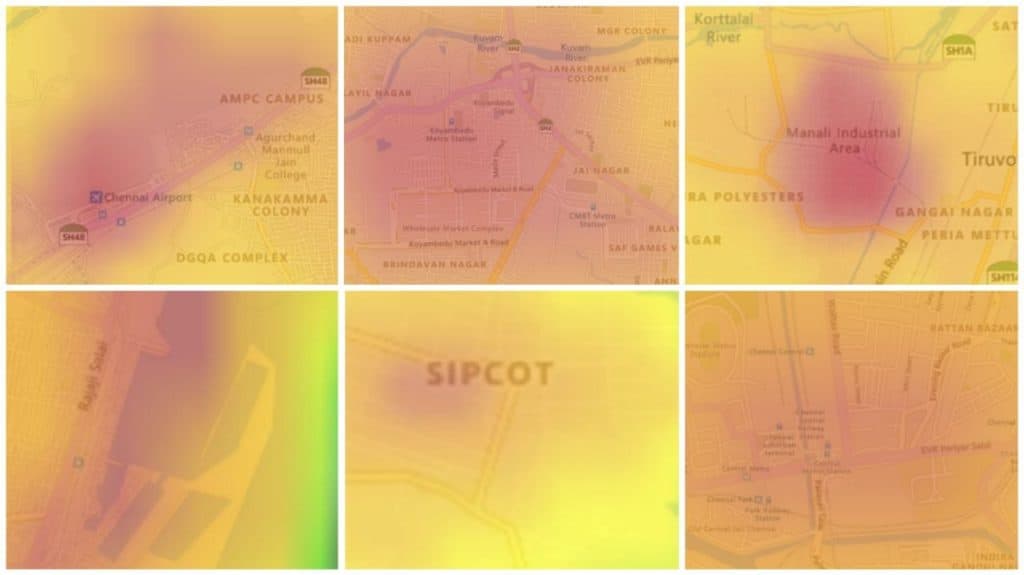
Ecological impact of light pollution
Light pollution has widespread ecological impact, especially in sensitive locations and for species that are depended on light for their survival.
Chennai is a nesting spot for Olive Ridley Turtles, which are currently classified as a ‘threatened’ species. The nesting season begins at the start of the year, with eggs taking 45 days to hatch. As the turtles hatch, the light from the sea guides them to the ocean, their natural habitat.
Artificial lights are widespread in and around the beaches of Chennai where the Olive Ridley Turtles lay eggs. These lights drown out the light from the sea. The bright lights on the land confuse the turtle hatchlings, veering them away from the ocean towards the illuminated roads. “They can be hit by a vehicle or eaten by a dog, as a result,” said Yuvan.
Special efforts have been made to protect the turtles by creating hatcheries and releasing them in the dark due to the ill effects of light pollution interrupting the natural process of them entering the sea.
“Apart from turtles, other aquatic animals are also affected by light,” said TD Babu, a marine biologist. “The breeding and feeding processes of aquatic animals depend on light. Artificial illumination will affect the biological clock of aquatic organisms as well,” he added.
Light pollution also affects plants and insects.
“There is a decline in the number of pollinating insects like bees. They travel using the light from stars and the moon at night. When there are bright artificial lights, they end up going near the light sources and lose their orientation, and they sometimes die,” said Yuvan. If there are no bees, it would have everlasting impact on the food chains, and could aggravate food insecurity issues in the world.
“Some shopkeepers wind lights around trees to attract customers to their shops,” noted Shobha Menon, founder of Nizhal, an NGO working towards the conservation of trees. “The ambient temperature of the bark surface increases and insects succumb to this.”
Apart from this, plants are also highly affected by light pollution. “Some plants bloom only at night. Increased [artificial] lighting can prevent flowering and pollination in such plants,” said Shobha. On the other hand, other trees assume artificial light to be natural light. Therefore the natural cycles of the trees during the day and night are hampered, which will only end their life sooner.
“Trees provide habitat for other organisms like insects, birds, animals and even microbes. When trees are affected, these organisms are also affected,” added Babu.
Light pollution may also fan the fire of climate change by adding heat into the atmosphere.
Are humans affected by light pollution?
Light pollution affects every organism. The sleep-wake cycle of a living being affects its physiological and psychological processes. This biological clock refers to the circadian rhythm of an organism. Diurnal organisms like humans sleep at night and are awake during the day, unlike nocturnal organisms like moths and owls.
“If there is a change in that [sleep-wake cycle], the whole rhythm will be disturbed,” said Dr S Manju, a general physician. She added that artificial lights can highly affect sleep patterns, putting off the circadian rhythm.
“Melatonin hormone is produced during the night in the human body. This will make you sleep. If melatonin is reduced, your sleep is disturbed, not letting your body and mind relax,” explained Dr Manju. Melatonin regulates the immune system as well. In the presence of extremely bright, artificial light, melatonin production comes down, disturbing the circadian cycle and harming the immune system. “High exposure to artificial light at night can even lead to breast cancer,” said Dr Manju.
Research suggests that women who work night shifts are more vulnerable to breast cancer because they are predominantly in the presence of artificial light. She said that melatonin can be produced efficiently only in darkness, even if people working the night shift sleep during the day.
High stress and depression, which will lead to hypertension, are also among the psychological effects of light pollution.
Read more: Chennai in darkness: What is wrong with our street lights?
How can light pollution in Chennai be addressed?
How can a growing city like Chennai combat light pollution while balancing concerns around safety at the same time?
“If there is public movement in night hours, there should be light,” said a retired IPS officer who did not wish to be named. “We cannot do away with light, but we can reduce the intensity of brightness and reduce public accessibility to eco-sensitive areas at night,” he suggested.
“Lack of lights can lead to low visibility, which will, in turn, lead to accidents,” said Santhosh Loganaathan, an urban planner with ITDP. “But the light pollution from private residences and apartment complexes still poses a threat. There are very few guidelines available for the general public on these terms,” he added.
One solution could be to regulate the amount of lighting permissible in eco-sensitive zones in the city.
“Chennai’s blue spaces like the banks of Adyar and Cooum river currently do not have much lighting along the edges, and even parks like Adyar Poonga do not have lights so as not to disturb the biodiversity around,” said Santhosh. “Even the high mast lights on the beaches are turned off after 11 pm to aid the nesting turtles. Private beach resorts too were instructed to turn the lights off after that time.”
“Light on and near the beaches can be reduced,” said Babu. However, the stretch of coast from Marina Beach up to Royapuram has the highest light pollution, according to the Light Pollution Map, which raises concerns.
“Technology has improved greatly, so that we can set up focussed lights to illuminate the roads and not the trees or other eco-sensitive areas,” added Babu. Santhosh suggested that street lights must be placed above tree levels.
“There is no generic solution to battle light pollution,” said Vetriselvan, an environmental advocate with Poovulagin Nanbargal. “There are different kinds of ecosystems, and each of them would have different limits of light intensities. This should be considered while making policies on light pollution,” he added.
Yuvan suggested that there should be a policy to reduce artificial lights in shops and other commercial establishments as well to minimise light pollution in the city.
“The concept of light pollution is usually not part of the curricula of environmental science and engineering programmes in Chennai,” said Prabhakaran Veerarasu, environmental engineer.
Many college professors we spoke to also feel that light pollution is uncharted territory when compared to air, water and noise pollution. There has been no academic research done on light pollution in Chennai. However, there are a small number of studies exploring the effects of light pollution in India. This area needs further attention.
Currently, there are no laws in India to monitor light pollution but considering the growing impact of light pollution across cities, specific solutions must be mooted at the city-level to combat ill effects.
“Light is associated with everything good, while darkness is associated with negativity in a philosophical sense. We need to understand that even darkness can be good and light can be bad to start realising light pollution as a major issue,” says Nivetha Murugesan, a PhD scholar in Evolutionary Biology, who has authored the book Oliyile Therivadhu (What is visible in the light) on light pollution and its impact.